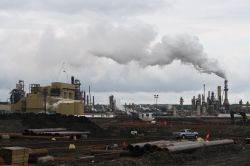Coop média de Montréal
Journalisme indépendant
Sands of Loam and Tears
FORT MCMURRAY, AB -- We are 500 followers of that which we follow. The procession lines the side of the road, squeezed tightly into one lane to allow oncoming traffic to pass. Mud-caked trucks, dusty Ford pick-ups and sporty Mercedes Benzes pass us non-stop. We walk flatly on the pavement, lead by Elders from the various Indigenous nations that have been affected, from near and from far, by the Canadian extractive industry.
We walk just next to highway 63, which joins Edmonton to Alberta's north and stretches to the depths of the tar sands. The highway veers away from the Athabasca for a moment, forming a loop near Syncrude's oil facilities.
The first testimony is noisy. Just as we enter the loop, we hear the sound of a canon. Soft, but regular. We are told that it serves to keep the birds away from the tailings ponds, those vast bodies of used, highly toxic water, full of mercury, benzene, and arsenic. In the energy industry, this is known as a “dissuasion mechanism.” It has been mandatory since 2008, when nearly 1,600 migratory birds died following a lethal layover on a tailings pond.
A little further, we finally catch sight of this pond and our group already feels burdened by this first spectacle of destruction. It stretches as far as one can see, forming an artificial lake from which rise dozens of orange scarecrows shaped like humans. These, too, serve to dissuade.
The landscape’s desolation scrolls as the environmental destruction speeds up. During the 14 kilometers of the Healing Walk, we must wear masks. Less than an hour after we began marching, several people complain of headaches. At one moment, I took off my mask to lick my lips. A sulfurous taste greeted my tongue. I felt like I was soaking in the fumes of hydrocarbons. In the distance, a vertical tower spits into the sky smoke so thick and white that it mixes with the clouds to the point where it's impossible to tell where one ends and the other begins.
There was something perfectly Orwellian about the tar sands landscape. Twenty kilometres from the Syncrude installation, a “green zone” had been created by another oil company. Suncor, a Canadian corporation, had transformed a former mining claim into a “nature trail” devoted to the protection of birds. At the entrance to the area, there are two metallic birds erected on a block of granite. At the their feet, Suncor's logo. Nearby, a sign that asks visitors, “Please do not disturb the ecosystem.”
At the heart of Syncrude's installations, we see gigantic skeletons curving their silver pipes. They are lit up like the buildings of a metropolis. In the foreground, we see camp barracks. A half-dozen. All identical. Fourteen windows on the side of the building. Each with its own air conditioner. This is where the company's workers live. A phantom population hidden behind the scale of the destruction. In the area, there are more than 10,000 of them.
We walked for more than five hours, led by the First Nations Elders. We heard that an oily sheen has been found on the Athabasca River and that it was getting dangerously close to the Fort Chipewyan First Nation. No oil company confirmed the spill. Yet, dead fish were found. As a precaution, Fort Chipewyan stopped using water from the river. A blockade of highway 63 is now being planned for the end of August.
Arij Riahi is a Montreal-based writer. She likes to play on @arijactually. This post was initially published in French in Journal des alternatives and was translated with the help of a kind friend.
About the poster
The site for the Montreal local of The Media Co-op has been archived and will no longer be updated. Please visit the main Media Co-op website to learn more about the organization.




